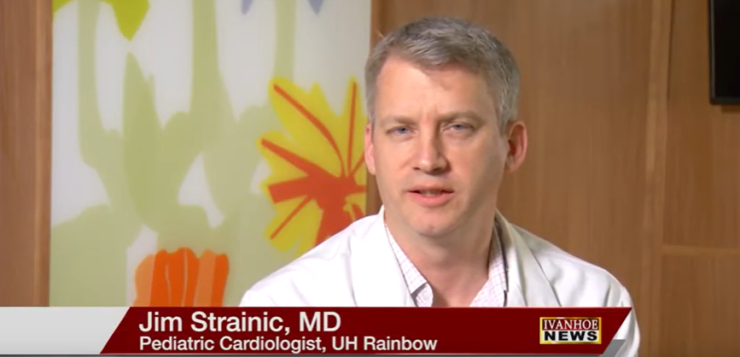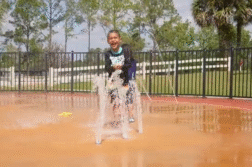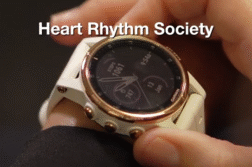James Strainic, MD, Director of the Fetal Heart Program, Pediatric Radiologist, speaks about a new procedure that occurs during pregnancy to ensure a safe birth.
Can you explain what is HLHS?
STRAINIC: Hypoplastic left heart syndrome is where the left-pumping chamber of the heart doesn’t form properly, and it’s too small. It can’t do the job of getting blood to the heart.
How early can you detect it, and how do you detect it?
STRAINIC: You can detect it in utero. Our obstetrical colleagues can detect it when they do an ultrasound as early as 12 to 14 weeks in some cases. But typically, it’s detected on an ultrasound at 18 to 22 weeks of gestation.
And, if a baby was diagnosed with this, what were the chances of survival?
STRAINIC: The chances of survival are getting better and better with hypoplastic left heart syndrome. But the life expectancy is short. It’s in the 20 to 30 years of life. And then, that heart will start to fail.
How many babies are diagnosed with it and live past a couple of months?
STRAINIC: About 1 in 100 babies are born with some type of congenital heart defect. And of those babies, about 10 to 15% will have hypoplastic left heart syndrome. If there’s no surgery or procedure done, the babies will only live a few days. But we can do procedures to reroute the blood to kind of bypass that missing part of the heart. Those patients can live up to 20 to 30 years.
Tell us about Lorenzo’s story.
STRAINIC: Lorenzo had a heart defect, which was called impending hypoplastic left heart syndrome. He had not developed too small of a heart yet. But the trajectory of where he was going, he would have developed this hypoplastic left heart syndrome. He had a blockage of his aortic valve. You can imagine it as if the valve’s a door and the door is stuck. The heart’s trying to push up against that stuck door and it starts to fail. Then, it’ll shrink. What we did was open up that valve. We forced open the door. Then, the left ventricle could do its job and continue to grow.
At what week was he?
STRAINIC: He was found around 18 weeks of gestation by our obstetrical colleague and referred to me. During that procedure, he was around 24 weeks of gestation.
How exactly does the procedure work?
STRAINIC: The procedure involves a large group of people. It involves our maternal fetal medicine specialist, or doctor who takes care of high-risk moms. It involves a pediatric cardiac interventionalist, or someone who specializes in doing procedures on an infant heart. And then, it also involves a fetal cardiologist, like me, who takes pictures of the fetus. This is a minimally invasive procedure. We only use a needle. There’s no cutting, no surgery. It’s ultrasound-guided. I guide the maternal fetal medicine specialist as she’s inserting the needle. The needle goes through mom’s skin, through the uterus and through the baby’s chest and into the heart. And for perspective, the heart is about the size of a grape or a small strawberry. And, you’re about 10 centimeters away from that as you’re trying to get to it blindly with just the ultrasound. It’s an impressive procedure. So, our maternal fetal medicine specialist gets the needle in and has to hold that needle perfectly still as the interventionalist places a balloon through that needle into the aortic valve. Then, our other interventional colleague expands the balloon because they can’t do both things at the same time. This procedure in all takes five doctors around the mom’s belly, but then an entire team supporting the mom. All in all, there’s about 20 people in the room for the procedure, including the mom.
How long does the procedure take?
STRAINIC: It depends on the fetus. Fetuses tend not to cooperate all the time. And they move around. So, we must wait until the fetus is in the perfect position. That’s the longest part of the whole procedure is waiting until the fetus gets into the right position. After that, the procedure takes about 15 to 20 minutes.
What do you tell the mom about the procedure regarding if the baby will survive?
STRAINIC: In Lorenzo’s case, we quoted her a 20% chance that he would survive and get to where he is today. He had a very abnormal left, and other left-sided, valve as well called the mitral valve. The combination of these two things is very bad. About 80% of these kids don’t make it. So, he really did beat the odds to make it where he is right now.
Will Lorenzo have to be checked up on forever? Does he face that risk of living to only 20 or 30 years?
STRAINIC: He no longer faces that risk of only living to 20 to 40 years. He does require frequent visits with me. I see him about every six months now, and there’s a good chance that he’ll need another procedure. His aortic valve, the main body artery valve is abnormal. We will probably have to replace that valve. But we’re really hoping that it won’t be in his teens or 20’s. Kids who have an aortic valve replacement do very well compared to kids who have hypoplastic left heart syndrome.
Does it amaze you when you see him?
STRAINIC: He is very cute and really funny. He is the smallest of three brothers. So, he’s constantly trying to keep up with the older kids. He was only here in the hospital for four days. He probably could’ve gone home in two. He was doing that well after he was born. He did require one procedure at around three to four weeks of age where we had to redo the valve procedure. But since then, he’s been doing great.
Does that amaze you or even surprise you that he walked out of the hospital after four days?
STRAINIC: That was really great that he was able to leave the hospital at three or four days of life. Most of the kids need more than one procedure. We predicted and told the parents that it’s likely that he’d need an aortic valve replacement in the first year of life. Well, he hasn’t. He’s been doing fantastic.
Interview conducted by Ivanhoe Broadcast News in December 2018.
END OF INTERVIEW
This information is intended for additional research purposes only. It is not to be used as a prescription or advice from Ivanhoe Broadcast News, Inc. or any medical professional interviewed. Ivanhoe Broadcast News, Inc. assumes no responsibility for the depth or accuracy of physician statements. Procedures or medicines apply to different people and medical factors; always consult your physician on medical matters.
If you would like more information, please contact:
Katelyn McCarthy
Katelyn.mccarthy@uhhospitals.org
Sign up for a free weekly e-mail on Medical Breakthroughs called First to Know by clicking here





